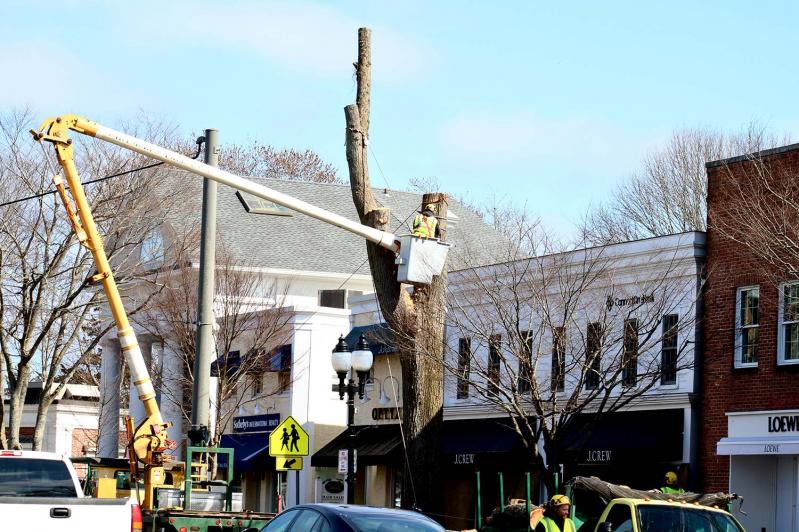Last week, two large American elm trees, estimated to be between 80 and 100 years old, were cut down at the intersection of Main Street and Newtown Lane: one in front of Louis Vuitton, and the other in front of J. Crew. Neither had Dutch elm disease, according to Olivia Brooks, the chairwoman of the 25-person Ladies Village Improvement Society tree committee since 2008, but both had simply reached the end of their long lives.
There are just under 100 American elm trees left in the village.
“It’s important for everyone to understand that there is a life cycle, just like with humans,” Ms. Brooks said by phone last week as people were bemoaning the felling of the big trees in person and on social media. “They’re living things. We’re doing everything we can to hold onto them, but there comes a time when you can’t.”
It cost the village about $7,000 for each of the large elms to come down.
Their removal is significant because they were located at the busiest and most visible crossroads in East Hampton Village, whose identity and reputation as “the most beautiful village in America” stems, in part, from its famous elms.
Ms. Brooks, sensing their importance, sought to alert the community to their impending removal by publishing a “Guestwords” column in The East Hampton Star this past October. Nonetheless, after they were felled, social media was abuzz, critiquing the unwelcome starkness in the heart of downtown.
“I’ve been listening to stories about those two trees for a while,” said Ms. Brooks. “It’s unbelievable they didn’t succumb to D.E.D. They were so compromised, due to the sidewalk and street, and becoming extremely dangerous.” She visited the trees in mid-February with Robert Strubel, the arborist for the L.V.I.S. and the general manager of the Bayberry Garden Center in Amagansett, and they agreed the time had come.
According to Marcos Baladron, the village administrator, no business had complained directly to the village, and there were no injuries, or reported property damage, because of falling limbs.
“We try to prune out all the dead wood. We did everything we could,” said Ms. Brooks. “I thought for the last few years they were looking better. They leafed out, but there were major branches that were starting to break. They had started to fall apart. Branches were falling on top of nearby buildings, but also on the sidewalks and cars. We knew their time was up, so it wasn’t a matter of if we were going to take them down, but when.”
Mike Bouker, the deputy superintendent of public works for the village, said of the timing, “This time of year is the least impactful time for residents, and we try to do it when it has the least impact.” He said another large American elm, located in front of the L.V.I.S., was the only other large tree slated for removal. That tree was girdled last July to prevent the spread of Dutch elm disease to other nearby trees. About 20 elms have been removed in recent years, according to Mr. Bouker, and anywhere from two to four in each of the last three years, due to a burst of the disease.
Dana Tripp, a certified arborist with Whitmores Inc., who did the work, said when removing trees of that size a lot of logistics and planning happen ahead of time, including for traffic and pedestrian safety. “There’s a lot of infrastructure nearby: buildings, light posts, and signs. That wood weighs a lot, and when you put it in motion, it weighs even more. You have to take it apart in pieces.” Whitmores has worked with the village, and its trees, since the 1970s.
Mr. Tripp hadn’t yet counted all the rings to ascertain the exact age of the trees, but with a quick glance, he noticed that during their younger years, when they were between 15 and 20 years old, the annual rings were wide, indicating they had grown rapidly and were “happy.”
“Urban trees are difficult to get established,” he said. “That’s why having these big trees in the village is so unique. There are not many cities that harbor healthy trees of this size. Urban trees typically last only seven to 10 years, because they’re only growing in that 10-by-10 enclosure.”
Mr. Tripp said eventually, once it’s understood where all the underground utilities are, the stumps of the once massive trees will be ground, and the size of the pit will indicate its capacity for a new root ball. Then a new tree will be planted.
“It’s sad to see these trees being removed,” he said. “But it gives an opportunity for the next generation.” The succession plan is being worked out between the village and the L.V.I.S. Ms. Brooks said no decision had been made yet on what species would be planted, as it is dependent on the conditions underground. Gingkos, honey locusts, and London plane trees are all being considered. In the 1970s, when Dutch elm disease first hit, the village planted zelkovas, a Japanese variety in the elm family.




